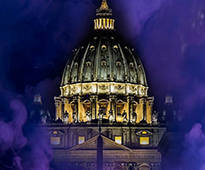| Recent Featured Videos and Articles | Eastern “Orthodoxy” Refuted | How To Avoid Sin | The Antichrist Identified! | What Fake Christians Get Wrong About Ephesians | Why So Many Can't Believe | “Magicians” Prove A Spiritual World Exists | Amazing Evidence For God | News Links |
| Vatican II “Catholic” Church Exposed | Steps To Convert | Outside The Church There Is No Salvation | E-Exchanges | The Holy Rosary | Padre Pio | Traditional Catholic Issues And Groups | Help Save Souls: Donate |  |









 " />
" /> " />
" /> " />
" /> " />
" /> " />
" />




Why a Christian can only be a Catholic
A Christian is someone who follows the true faith of Jesus Christ.
In the Acts of the Apostles we read that it was at Antioch that the followers of Christ were first called Christians.
Interestingly, it was also at Antioch (in the year 110) that the term “Catholic” was first applied to the Christian Church. This was done by the famous martyr of the ancient Christian Church, St. Ignatius.
In Greek, the term “Catholic” means universal. Thus, the one universal Christian Church came to be known as the Catholic Church. It makes sense that the terms Christian and Catholic became interchangeable, for the one Christian Church which existed from the beginning was the Catholic Church. Ignatius had a real connection to the original Christians. He was the third bishop of Antioch. Ignatius knew St. Polycarp who knew the apostle John himself.
Many think that being Christian means accepting everyone, being kind to everyone. Certainly being Christian involves a true charity toward all men. This means that you work for and desire each man’s salvation (his eternal happiness). First and foremost, however, being a Christian requires that one believe all the truths of Jesus Christ. It requires that one hear the one Church He established. Jesus Himself declared that preaching the Christian faith (the Gospel) means “teaching them to observe all things whatsoever I have commanded you” (Matthew 28:19). In Matthew 18:17, we read that those who don’t hear the Christian Church established by Jesus are to be considered as the “heathen and publican.”
The true Christian faith has a real power. This power is of course identified with the miracles of its founder, the God-man, Jesus Christ. But the power of the Christian faith didn’t dry up and disappear once Jesus ascended into Heaven. No, Jesus left that power with His Church. He left it not only in the miracles which He said some His followers would perform (John 14:12), but in the supernatural protection and guidance which would sustain His visible Christian institution. In Matthew 16:18-20 we read that this Christian Church structure was founded on the apostle Peter, who would be the first pope. This visible Christian structure would be an ongoing testament to Jesus Christ’s power. It would guide the Christians on the way of truth. It would also be necessary for salvation; for the Lord would add all who were to be true Christians to this one Christian Church (Acts 2:47).
One of the most striking events in Christian history, which illustrates the power of the Christian Church and its visible structure, involved the Attila the Hun and his invasion of Italy in 452. Attila was a fierce non-Christian emperor in the East. He was greatly feared by many in the Christian Roman Empire. In 447, Attila invaded the Eastern Empire. In 452, he was ready to invade Rome itself, the center of the Christian Church. With Atila threatening the center of the Christian Church, Pope Leo the Great (the undisputed leader of the Christian Church) faced him down. He went out to meet Atilla. As Pope Leo went out to meet Attila, he was miraculously flanked by the apostle Peter. History tells us that St. Peter threatened Attila with death if he should proceed further. Attila was so frightened that he turned back. If Attila had not turned back, all of history might have been different. The leader of the Christian Church carried with him the supernatural protection of Christianity’s founder, the Lord Jesus Christ.
Each century that followed the establishment of the Church brought new challenges and trials for the Christian. Heresies would appear and lead many astray. Many who had been Christians wound up being separated from the true Church by these heresies. Arianism was the most notorious of all the early heresies. It proclaimed that Jesus Christ was not true God, that He was not equal with the Father. Arianism spread widely in the 4th century, leading to the apostasy of many.
The two central dogmas of the Christian faith are the mysteries of the Trinity and the Incarnation. The Trinity is the truth that there is one God in three divine persons: the Father, the Son and the Holy Ghost. Each divine person is God; yet there are not three gods, but one God. Each person is a distinct person. The Sabellian heretics, for example, wrongly taught that each person is simply a different aspect of God. According to them, the Father and the Son are different elements of the same person. This heresy was condemned by the Christian Church. A Christian must believe that there are three divine persons, that each one is God, but that there is only one God.
The other central dogma of the Christian faith is the Incarnation. This is the truth that the Second Person of the Holy Trinity, the Son of God, became man. That person is Jesus Christ. He is one divine person (the second person of the Holy Trinity) with two natures. He is true God and true man.
For more about the true Christian faith, which is necessary for salvation, please consult our website.
Sign up for our free e-mail list to see future vaticancatholic.com videos and articles.
Recent Content
^